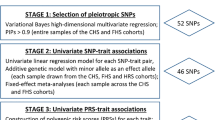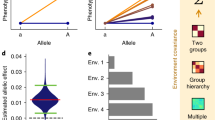Abstract
Genotype-by-environment interaction (GxE) studies probe heterogeneity in response to risk factors or interventions. Popular methods for estimation of GxE examine multiplicative interactions between individual genetic and environmental measures. However, risk factors and interventions may modulate the total variance of an epidemiological outcome that itself represents the aggregation of many other etiological components. We expand the traditional GxE model to directly model genetic and environmental moderation of the dispersion of the outcome. We derive a test statistic, \(\xi\), for inferring whether an interaction identified between individual genetic and environmental measures represents a more general pattern of moderation of the total variance in the phenotype by either the genetic or the environmental measure. We validate our method via extensive simulation, and apply it to investigate genotype-by-birth year interactions for Body Mass Index (BMI) with polygenic scores in the Health and Retirement Study (N = 11,586) and individual genetic variants in the UK Biobank (N = 380,605). We find that changes in the penetrance of a genome-wide polygenic score for BMI across birth year are partly representative of a more general pattern of expanding BMI variation across generations. Three individual variants found to be more strongly associated with BMI among later born individuals, were also associated with the magnitude of variability in BMI itself within any given birth year, suggesting that they may confer general sensitivity of BMI to a range of unmeasured factors beyond those captured by birth year. We introduce an expanded GxE regression model that explicitly models genetic and environmental moderation of the dispersion of the outcome under study. This approach can determine whether GxE interactions identified are specific to the measured predictors or represent a more general pattern of moderation of the total variance in the outcome by the genetic and environmental measures.


Similar content being viewed by others
Data Availability
Data is available as indicated in manuscript.
Code Availability
Code is available at https://github.com/ben-domingue/scalingGxE.
References
Box GE, Cox DR (1964) An analysis of transformations. J R Stat Soc Ser B 26:211–43
Brandkvist M, Bjørngaard JH, Ødegård RA, Brumpton B, Smith GD, Åsvold BO, Sund ER, Kvaløy K, Willer CJ, Vie GÅ (2020) Genetic associations with temporal shifts in obesity and severe obesity during the obesity epidemic in Norway: a longitudinal population-based cohort (the HUNT Study). PLoS Med 17:e1003452
Browne WJ, Draper D, Goldstein H, Rasbash J (2002) Bayesian and likelihood methods for fitting multilevel models with complex level-1 variation. Comput Stat Data Anal 39:203–25
Conley D, Laidley TM, Boardman JD, Domingue BW (2016) Changing polygenic penetrance on phenotypes in the 20th century among adults in the US population. Sci Rep 6:30348
Conley D, Johnson R, Domingue B, Dawes C, Boardman J, Siegal M (2018) A sibling method for identifying vQTLs. PLoS ONE 13:e0194541
Demerath EW, Choh AC, Johnson W, Curran JE, Lee M, Bellis C, Dyer TD, Czerwinski SA, Blangero J, Towne B (2013) The positive association of obesity variants with adulthood adiposity strengthens over an 80-year period: a gene-by-birth year interaction. Hum Hered 75:175–85
Domingue BW, Belsky DW, Harrati A, Conley D, Weir DR, Boardman JD (2017) Mortality selection in a genetic sample and implications for association studies. Int J Epidemiol 46:1285–94
Domingue B, Trejo S, Armstrong-Carter E, Tucker-Drob EM (2020) Interactions between polygenic scores and environments: methodological and conceptual challenges. Sociol Sci 7:465–486
Dudbridge F (2013) Power and predictive accuracy of polygenic risk scores. PLoS Genet 9:e1003348
Duncan LE, Keller MC (2011) A critical review of the first 10 years of candidate gene-byenvironment interaction research in psychiatry. Am J Psychiatry 168:1041–9
Fang J, Gong C, Wan Y, Xu Y, Tao F, Sun Y (2019) Polygenic risk, adherence to a healthy lifestyle, and childhood obesity. Pediatric Obes 14
Flegal KM, Kruszon-Moran D, Carroll MD, Fryar CD, Ogden CL (2016) Trends in obesity among adults in the United States, 2005 to 2014. JAMA 315:2284–91
Fry A, Littlejohns TJ, Sudlow C, Doherty N, Adamska L, Sprosen T, Collins R, Allen NE (2017) Comparison of sociodemographic and health-related characteristics of UK Biobank participants with those of the general population. Am J Epidemiol 186:1026–34
Gelman A, Meng XL, Stern H (1996) Posterior predictive assessment of model fitness via realized discrepancies. Stat Sin 733–760
Hall DB, Severini TA (1998) Extended generalized estimating equations for clustered data. J Am Stat Assoc 93:1365–75
Hansen LP (1982) Large sample properties of generalized method of moments estimators. Econometrica 1029–1054
Johnson RA, Sotoudeh R, Conley D (2020) A new tool for studying gene-environment interplay. bioRxiv, Polygenic scores for plasticity
Juster FT, Suzman R (1995) An overview of the Health and Retirement Study. J Hum Resour S7–S56
Keller MC (2014) Gene\(\times\) environment interaction studies have not properly controlled for potential confounders: the problem and the (simple) solution. Biol Psychiatry 75:18–24
Kim R, Kawachi I, Coull BA, Subramanian SV (2018) Patterning of individual heterogeneity in body mass index: evidence from 57 low-and middle-income countries. Eur J Epidemiol 33:741–50
Komulainen K, Pulkki-Raback L, Jokela M, Lyytikäinen L, Pitkänen N, Laitinen T, Hintsanen M, Elovainio M, Hintsa T, Jula A et al (2018) Education as a moderator of genetic risk for higher body mass index: prospective cohort study from childhood to adulthood. Int J Obes 42:866–71
Lambert SA, Gil L, Jupp S, Ritchie SC, Xu Y, Buniello A, Abraham G, Chapman M, Parkinson H, Danesh J, et al. (2020) The Polygenic Score Catalog: an open database for reproducibility and systematic evaluation. medRxiv
Liu H, Guo G (2015) Lifetime socioeconomic status, historical context, and genetic inheritance in shaping body mass in middle and late adulthood. Am Sociol Rev 80:705–37
Locke AE, Kahali B, Berndt SI, Justice AE, Pers TH, Day FR, Powell C, Vedantam S, Buchkovich ML, Yang J et al (2015) Genetic studies of body mass index yield new insights for obesity biology. Nature 518:197–206
Majumdar A, Burch K, Sankararaman S, Pasaniuc B, Gauderman WJ, and Witte JS (2020) A two-step approach to testing overall effect of gene-environment interaction for multiple phenotypes. bioRxiv
Mansournia MA, Nazemipour M, Naimi AI, Collins GS, Campbell MJ (2020) Reflections on modern methods: demystifying robust standard errors for epidemiologists. Int J Epidemiol
Marderstein AR, Davenport E, Kulm S, Van Hout CV, Elemento O, Clark AG (2020) Leveraging phenotypic variability to identify genetic interactions in human phenotypes. bioRxiv
McAllister K, Mechanic LE, Amos C, Aschard H, Blair IA, Chatterjee N, Conti D, Gauderman WJ, Hsu L, Hutter CM et al (2017) Current challenges and new opportunities for gene-environment interaction studies of complex diseases. Am J Epidemiol 186:753–61
Mills MC, Barban N, Tropf FC (2020) An introduction to statistical genetic data analysis. MIT Press, New York
Ni G, van der Werf J, Zhou X, Hyppönen E, Wray NR, Lee SH (2019) Genotype-covariate correlation and interaction disentangled by a whole-genome multivariate reaction norm model. Nat Commun 10:1–15
Ogden CL, Fryar CD, Martin CB, Freedman DS, Carroll MD, Gu Q, Hales CM (2020) Trends in obesity prevalence by race and hispanic origin—1999-2000 to 2017–2018. JAMA
Peterson RA (2021) Finding optimal normalizing transformations via bestNormalize. R J
Purcell S (2002) Variance components models for gene-environment interaction in twin analysis. Twin Res Hum Genet 5:554–71
Qi Q, Chu AY, Kang JH, Jensen MK, Curhan GC, Pasquale LR, Ridker PM, Hunter DJ, Willett WC, Rimm EB et al (2012) Sugar-sweetened beverages and genetic risk of obesity. N Engl J Med 367:1387–96
Qi Q, Chu AY, Kang JH, Huang J, Rose LM, Jensen MK, Liang L, Curhan GC, Pasquale LR, Wiggs JL et al (2014) Fried food consumption, genetic risk, and body mass index: gene-diet interaction analysis in three US cohort studies. BMJ 348:g1610
Ritz BR, Chatterjee N, Garcia-Closas M, Gauderman WJ, Pierce BL, Kraft P, Tanner CM, Mechanic LE, McAllister K (2017) Lessons learned from past gene-environment interaction successes. Am J Epidemiol 186:778–86
Rosenquist JN, Lehrer SF, O’Malley AJ, Zaslavsky AM, Smoller JW, Christakis NA (2015) Cohort of birth modifies the association between FTO genotype and BMI. Proc Natl Acad Sci 112:354–9
Schmitz LL, Goodwin J, Miao J, Lu Q, Conley D (2021) The impact of late-career job loss and genetic risk on body mass index: evidence from variance polygenic scores. Sci Rep 11:1–15
Shin J, Lee SH (2020) GxEsum: genotype-by-environment interaction model based on summary statistics. BioRxiv
Tabery J (2007) Biometric and developmental gene-environment interactions: looking back, moving forward. Dev Psychopathol 19:961–76
Verhoeven VJ, Buitendijk GH, Rivadeneira F, Uitterlinden AG, Vingerling JR, Hofman A, Klaver CC et al (2013) Education influences the role of genetics in myopia. Eur J Epidemiol 28:973–80
Walter S, Mejıa-Guevara I, Estrada K, Liu SY, Glymour MM (2016) Association of a genetic risk score with body mass index across different birth cohorts. JAMA 316:63–9
Wang H, Zhang F, Zeng J, Wu Y, Kemper KE, Xue A, Zhang M, Powell JE, Goddard ME, Wray NR et al (2019) Genotype-by-environment interactions inferred from genetic effects on phenotypic variability in the UK Biobank. Sci Adv 5:eaaw3538
Ware E, Schmitz L, Gard A, Faul J (2018) HRS polygenic scores-release 3: 2006–2012 genetic data. Survey Research Center, University of Michigan, Ann Arbor
Yang J, Loos RJ, Powell JE, Medland SE, Speliotes EK, Chasman DI, Rose LM, Thorleifsson G, Steinthorsdottir V, Mägi R et al (2012) FTO genotype is associated with phenotypic variability of body mass index. Nature 490:267–72
Young AI, Wauthier FL, Donnelly P (2018) Identifying loci affecting trait variability and detecting interactions in genome-wide association studies. Nat Genet 50:1608–14
Acknowledgements
The authors would like to thank Dan Benjamin, Dalton Conley, Michel Nivard, Paul Rathouz, Mijke Rhemtulla, Subu Subramanian, and Patrick Turley for helpful comments on an early version of this manuscript. This research was conducted using the UK Biobank Resource (Application No. 36046).
Funding
This work was supported in part by the National Science Foundation Graduate Research Fellowship Program under Grant No. DGE-1656518 (ST), by the Institute of Education Sciences under Grant No. R305B140009 (ST), by NIH grants R01MH120219, R01AG054628, and R01HD083613 (EMTD), and by the Jacobs Foundation (EMTD). Any opinions expressed are those of the authors alone and should not be construed as representing the opinions of funding agencies. EMTD is a member of the Population Research Center and the Center for Aging and Population Sciences at the University of Texas at Austin, which are funded by NIH center grants P2CHD042849 and P30AG066614, respectively.
Author information
Authors and Affiliations
Contributions
BWD and ETMD designed the study with additional input from KK. BWD, TMT, and EMTD contributed to analysis. All authors were involved in drafting the manuscript.
Corresponding authors
Ethics declarations
Conflict of interest
Benjamin W. Domingue, Klint Kanopka, Travis T. Mallard, Sam Trejo, and Elliot M. Tucker-Drob declare that they have no conflict of interest.
Human and Animal Rights and Informed consent
De-identified data from the Health and Retirement study and the UK Biobank were analyzed for this article. As none of the authors of this article was involved in the original data collection and none has access to participant identifiers from either project, this research reported here does not constitute human subject research. This article does not report results of any studies with non-human animals performed by any of the authors.
Additional information
Edited by Stacey Cherny.
Publisher's Note
Springer Nature remains neutral with regard to jurisdictional claims in published maps and institutional affiliations.
Supplementary Information
Below is the link to the electronic supplementary material.
Rights and permissions
About this article
Cite this article
Domingue, B.W., Kanopka, K., Mallard, T.T. et al. Modeling Interaction and Dispersion Effects in the Analysis of Gene-by-Environment Interaction. Behav Genet 52, 56–64 (2022). https://doi.org/10.1007/s10519-021-10090-8
Received:
Accepted:
Published:
Issue Date:
DOI: https://doi.org/10.1007/s10519-021-10090-8




